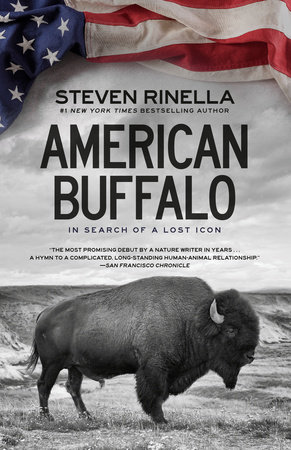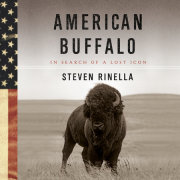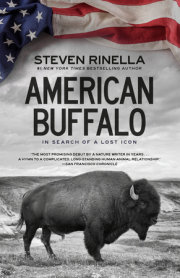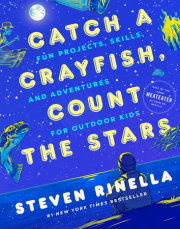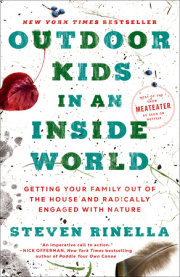1
In the past week I’ve become something of a buffalo chip connoisseur. The perfect specimen has the circumference of a baseball cap, with folded layers like a sheik’s turban. It’s as dense as a gingersnap cookie, with the color and texture of old cardboard that’s been wet and dried out again. Of course, when I say “buffalo chip,” I’m talking about buffalo dung, or what’s left of vegetation after it passes through the digestive circuitry of North America’s largest native land animal, also known as the American bison (Bison bison). These chips will burn with an orange-colored halo of flame surrounding a coal black center; they let off a good heat, not many sparks, and a blue-hued smoke that smells nothing like you’d expect it to. At times I’ve dipped my face into the smoke and picked up the odors of cinnamon and cloves, dried straw and pumpkins, and sometimes the smell of walking into a bathroom after someone smoked a joint.
If I were to leave my buffalo chip fire right now, it would take me about a half hour to stomp my way through the thickets of spruce and alder that separate me from the Chetaslina River, a fast-flowing torrent of glacial runoff that drains a collection of fourteen-thousand-foot peaks in the Wrangell Mountains of south-central Alaska. If I tossed a stick into the Chetaslina River, it would drift through three miles of narrow canyon before dumping into the cold gray swirl of the much larger Copper River. From there the stick would flow more or less southward, past a couple of small villages and dozens of fish traps that were recently dragged onto the banks by their owners to save them from the crushing floes of winter ice. After dodging past mountains and winding through canyons, the stick would enter the Gulf of Alaska outside of Prince William Sound. As the crow flies (or, as is more likely in these parts, the raven), that’s about eighty miles from here. Along the way, the crow would cross one two-lane highway and any number of wolves, coyotes, lynx, black bears, grizzly bears, wolverines, mountain goats, Dall sheep, and moose.
And perhaps a herd or two of wandering buffalo. Earlier in the morning there were about twenty of them in this valley; one of them, a cow, or female, is now lying just uphill from me within arm’s reach. Probably about six hundred pounds of hide, bone, horn, and innards. Another four hundred or five hundred pounds of meat. When it fell dead, after I shot it, it slid down the steep slope across the wet slush and crashed into a snag of aspen trees. I’ve been working on it all day. I made skinning cuts up the legs and then opened the carcass from the underside of the tail to the chin before removing the entrails. With short, fast slices from my skinning knife, I pulled the hide away from the upper half of the carcass as if I were slowly turning down the covers of a bed. I skinned over the brisket, ribs, and paunch, then up and over the shoulder all the way to the animal’s spine. If you touch the base of your own neck and feel the pebble-like shapes running up the center of your backbone, you’re feeling the neural processes of your thoracic vertebrae. On a buffalo, those things can be over twenty inches long; they act as a sort of mooring post for tendons that support the animal’s shag-haired, curve-horned head. The hump gives the buffalo its distinctive look, its front-heavy, bulldozer, mass-shouldered appearance.
I’ve been rationing my food for the last few days, and now I can eat all I want. I cut some slices of fat from behind the hump and then pull the hide back in place to keep the carcass from freezing too solid to work on. The fat has an orangish color, not like the white fat you see on grain-fattened beef. The orange is from a diet of wild plants that are rich in fat-soluble carotene, the same substance that colors a carrot. The heat of the fire liquefies the fat and leaves the cracklings floating in the oil of my pan like if you melted hard candy and all the wrappers came to the surface. Whenever a crackling becomes rendered out, I pinch it out with the pliers on my Leatherman and blow on it until it’s cooled off and crispy. I was keeping my salt in a film canister sealed with duct tape, but sometime over the last week, when I was crossing a river or standing in the rain or snow, the salt got wet. I scrape a chunk out with my knife and then grind it back into grains between my fingers. With a bit of salt, the cracklings taste like pork rinds but much better. They taste wilder.
You can say all you want about Coca-Cola and hot dogs and apple pie, but this is the real original American meal right here, buffalo meat; when the first Americans arrived in the Western Hemisphere, having crossed from eastern Siberia to Alaska, buffalo meat was one of the things that they were after. The animals were bigger then, with longer horns and probably shaggier hair, but it takes a trained eye to tell those skeletal remains apart from the ones I’m cleaning up with my knife.
The red-stained snow and the odor of blood in the air mean that I will not be alone here for long. Already gray jays are squawking around above my head and zipping in and out of the spruce trees. I hear the croak of a raven passing by. Yesterday morning I saw a wolf; last night I saw two grizzly bears, not a half mile from here. The bears were eating rose hips on a hillside in the falling snow. They were young but good-sized, a couple of four-hundred-pounders. I’ll bet they hear these excited birdcalls. When the sun ducks down toward the horizon, the thermal currents are going to switch direction and carry the smell right to them.
After I eat the fat and fry some little squares of meat, I load about a hundred pounds of the buffalo into my backpack and start through the trees toward the Chetaslina. From there it’s about a three-mile walk down to my main camp along the Copper River.
When I get to the Chetaslina, I see just what I didn’t want to see: two sets of grizzly tracks in the fresh snow, circling around near the riverbank. I check the air; sure enough, the tracks are downwind of the carcass. They already smell it. Shit. I unload the meat on the riverbank and drape it with some well-worn clothes and a sleeping bag to give it human odor. I light a little fire next to the meat and then march back up to the carcass and strip down out of my long underwear. My skin breaks out in gooseflesh before I can get dressed again. I drape the pants over the buffalo’s horns and make a little scarecrow with the top. Then I piss on a few trees to mark my territory. That’s as much as I can do, unless I want to sleep here and take my chances in the dark.
And nope, I don’t want to sleep here. I gather up my pack and head back to the Chetaslina. There’s a set of grizzly tracks on my boot prints from just an hour ago, backtracking up my trail and then veering off into the spruce trees. I’m going to have to come back up here first thing in the morning, and I’m not looking forward to it. I get a rush of adrenaline at the thought of sorting out who’s going to get this buffalo meat, them or me. I’m planning on it being me.
2
I first became interested in buffalo because of a kick from my brother Matt’s boot on a mid-September afternoon in the late 1990s, at an elevation of about nine thousand feet above sea level in the Madison Mountains of southwest Montana. Matt and I, along with our brother Danny, had been up there for a few days bow hunting for elk. Snow had been on the ground a few days before, but it had turned sunny and you could smell the heat coming off the pine needles. The lodgepole pines on the mountainside were so thick that we sometimes had to turn sideways to pass between them--people call them dog hair pines when they’re like that. The slope was steep, but here and there the ground leveled off into room-sized benches. As we were crossing one of those benches, Matt kicked at something on the ground. It was just a half-assed kick, and he didn’t even slow down.
As I passed that spot, I looked to see what he had kicked at. It was a small circle of bone poking out of the forest floor. I gave it a kick, too, but it didn’t budge. I gave it a couple more kicks. Still nothing. The circle of bone looked like it might be the eye socket of an old elk skull. I was wondering if there were any antler stubs attached, so I pushed a stick into the circle and pried. The stick broke. I dug away enough dirt to see that the hole was actually a foramen magnum, the opening in the back of a skull where the spinal column passes through to the brain. But this foramen magnum looked different from an elk’s. I dug a couple gallons worth of dirt from around the object’s perimeter. After I wiggled it a few times, it popped free from the little roots with the sound of dry spaghetti snapping in half. I stood up with the skull and held it at arm’s length. It was the color of hot chocolate mix. The whole thing was woven over with green moss and roots. Everything below the eye sockets was missing: no jaws, no nose. But the moment that I saw it, I knew I’d just found a buffalo skull.
Ever since that day, I’m always a little surprised by the ways in which buffalo can come out of nowhere and suddenly pop up into one’s life. It’s actually become a game that I like to play with other people. The game has to do with random associations. I’ll be talking to friends or acquaintances at a party and I’ll try to seduce their interest with compelling buffalo-related facts and trivia. For instance, I might explain that there’s a town or city named Buffalo in eighteen states, though the most famous of these, Buffalo, New York, is the only one that never had a population of wild buffalo living in its vicinity.
Such discussions often make my partners in conversation uncomfortable or bored, and it’s amazing how often they bring up the word tatanka as an avenue of participation into the conversation. Tatanka is a Lakota word for buffalo. It was popularized by its frequent and animated use in Dances with Wolves, the 1990 film starring Kevin Costner. When a friend mentions this word, I build on the conversation’s momentum by adding a related tidbit of my own: during the filming of Dances with Wolves, I’ll say, which was shot in Canada, the filmmakers used buffalo that were owned by the Canadian-born musician Neil Young. Young once recorded a popular song called “Cortez the Killer” (1975), which was banned for a while by the Franco regime in Cortes’s native country of Spain. Hernando Cortes is of course the famed Spanish conquistador, and in A.D. 1519 he happened to be the first European to ever see an American buffalo. The animal was housed in the menagerie of the Aztecs’ godlike chief, Montezuma, in the Aztec capital of Tenochtitlan, which now lies in ruins beneath Mexico City. Cortés had no way of knowing it, but the captive buffalo was hundreds of miles south of its native range. Cortes hung around Tenochtitlan for a few years before he completely destroyed the place, from the Aztecs’ written records to Montezuma’s collection of hundreds of thousands of human skulls.
Before he recorded “Cortez the Killer,” Neil Young was an influential member of the band called Buffalo Springfield, known for their instrumental interplay and vocal harmony, put to use in antiwar songs such as “For What It’s Worth” (1967). The band’s name was inspired by the Buffalo-Springfield Roller Company, an American manufacturer of road-building equipment founded in 1916 with the merger of the Buffalo-Pitts and Kelly-Springfield companies. To put the words “Buffalo” and “Springfield” together was an interesting choice, however coincidental. The Springfield Armory of Massachusetts manufactured many of the weapons used by the Union in the Civil War. After the Civil War, many of those federal soldiers took their Springfield weapons westward and provided the military backbone for the suppression of the remaining free-ranging indigenous buffalo-hunting cultures on the Great Plains.
By now I’ll be on a roll: The most famous Plains Indian of all time was Crazy Horse, I’ll continue, the renegade Oglala Sioux warrior who was instrumental in the annihilation of General George Armstrong Custer’s command at the Battle of the Little Bighorn. As it happens, Crazy Horse was also the name of the band that Neil Young usually performed “Cortez the Killer” with. Crazy Horse, the man, would have certainly used the word tatanka, though most other assertions about his life are, as the novelist Larry McMurtry put it, “an exercise in assumption, conjecture, and surmise.” However, it is fairly certain that Crazy Horse had an affair with a married woman named Black Buffalo Woman. It’s less certain but still possible that his maternal grandfather was named Black Buffalo, and his maternal grandmother was named White Cow (as in white-colored female buffalo). It’s also rumored that one of Crazy Horse’s maternal uncles, One Horn, or Lone Horn, was gored to death by a buffalo. Crazy Horse himself died from bayonet wounds. There’s a legend that his deathbed statement mentioned the Tongue River. I used to live less than a mile from where the Tongue River flows into the Yellowstone River, in Miles City, Montana. When I lived there I liked to visit a place where Indians chased buffalo over a cliff’s edge hundreds of years ago. The buffalo jump, as such cliffs are known, is on the property of my brother Matt’s employer, the U.S. Department of Agriculture’s Fort Keogh Livestock and Range Research Laboratory. The laboratory takes its name from Captain Keogh, an Irishman who was rumored to be the last of Custer’s men to die while battling Crazy Horse at the Battle of the Little Bighorn.
Often, my game associations will take me to a discussion of the most famous buffalo in all of American history--that is, the one who touched the most human lives. Black Diamond was the buffalo from the buffalo-head nickel. His path to fame began in 1911, when the U.S. Mint was seeking a replacement for the Liberty-head nickel, which had been in circulation for twenty-eight years. The mint commissioned the sculptor James Earle Fraser to come up with a concept. Because the Liberty-head nickel had a Romanesque theme, Fraser thought that something more “American” was in order. He began researching his nickel in 1911. “And, in my search for symbols,” he later explained, “I found no motif within the boundaries of the United States so distinctive as the American buffalo or bison.”
Looking back on it, Fraser’s choice was peculiar. He was crafting a coin based on what was then a national embarrassment, as if today the U.S. Mint were to strike a coin featuring the American prison at Guantanamo Bay.
Copyright © 2008 by Steven Rinella. All rights reserved. No part of this excerpt may be reproduced or reprinted without permission in writing from the publisher.

